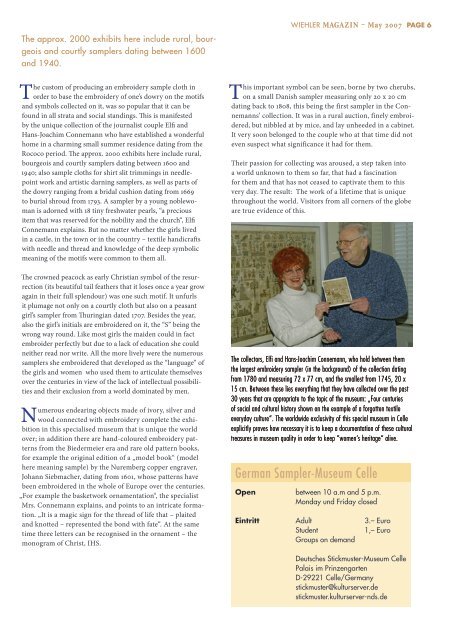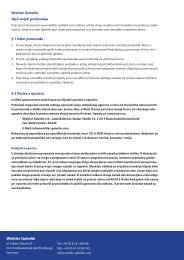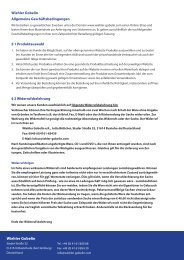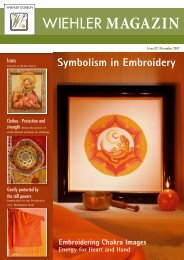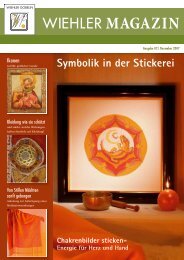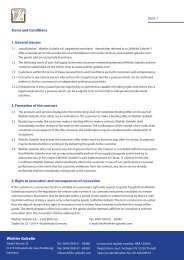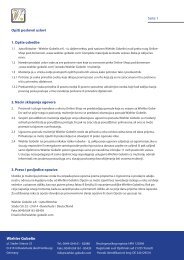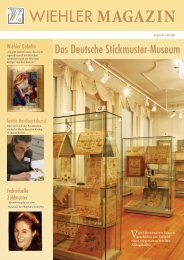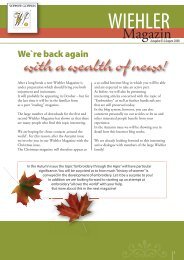Wiehler MAGAZIN - Wiehler Gobelin
Wiehler MAGAZIN - Wiehler Gobelin
Wiehler MAGAZIN - Wiehler Gobelin
You also want an ePaper? Increase the reach of your titles
YUMPU automatically turns print PDFs into web optimized ePapers that Google loves.
The approx. 2000 exhibits here include rural, bour-<br />
geois and courtly samplers dating between 1600<br />
and 1940.<br />
The custom of producing an embroidery sample cloth in<br />
order to base the embroidery of one’s dowry on the motifs<br />
and symbols collected on it, was so popular that it can be<br />
found in all strata and social standings. This is manifested<br />
by the unique collection of the journalist couple Elfi and<br />
Hans-Joachim Connemann who have established a wonderful<br />
home in a charming small summer residence dating from the<br />
Rococo period. The approx. 2000 exhibits here include rural,<br />
bourgeois and courtly samplers dating between 1600 and<br />
1940; also sample cloths for shirt slit trimmings in needlepoint<br />
work and artistic darning samplers, as well as parts of<br />
the dowry ranging from a bridal cushion dating from 1669<br />
to burial shroud from 1793. A sampler by a young noblewoman<br />
is adorned with 18 tiny freshwater pearls, “a precious<br />
item that was reserved for the nobility and the church“, Elfi<br />
Connemann explains. But no matter whether the girls lived<br />
in a castle, in the town or in the country – textile handicrafts<br />
with needle and thread and knowledge of the deep symbolic<br />
meaning of the motifs were common to them all.<br />
The crowned peacock as early Christian symbol of the resurrection<br />
(its beautiful tail feathers that it loses once a year grow<br />
again in their full splendour) was one such motif. It unfurls<br />
it plumage not only on a courtly cloth but also on a peasant<br />
girl’s sampler from Thuringian dated 1707. Besides the year,<br />
also the girl’s initials are embroidered on it, the “S” being the<br />
wrong way round. Like most girls the maiden could in fact<br />
embroider perfectly but due to a lack of education she could<br />
neither read nor write. All the more lively were the numerous<br />
samplers she embroidered that developed as the “language” of<br />
the girls and women who used them to articulate themselves<br />
over the centuries in view of the lack of intellectual possibilities<br />
and their exclusion from a world dominated by men.<br />
Numerous endearing objects made of ivory, silver and<br />
wood connected with embroidery complete the exhibition<br />
in this specialised museum that is unique the world<br />
over; in addition there are hand-coloured embroidery patterns<br />
from the Biedermeier era and rare old pattern books,<br />
for example the original edition of a „model book“ (model<br />
here meaning sample) by the Nuremberg copper engraver,<br />
Johann Siebmacher, dating from 1601, whose patterns have<br />
been embroidered in the whole of Europe over the centuries.<br />
„For example the basketwork ornamentation“, the specialist<br />
Mrs. Connemann explains, and points to an intricate formation.<br />
„It is a magic sign for the thread of life that – plaited<br />
and knotted – represented the bond with fate“. At the same<br />
time three letters can be recognised in the ornament – the<br />
monogram of Christ, IHS.<br />
<strong>Wiehler</strong> <strong>MAGAZIN</strong> – May 2007 Page<br />
This important symbol can be seen, borne by two cherubs,<br />
on a small Danish sampler measuring only 20 x 20 cm<br />
dating back to 1808, this being the first sampler in the Connemanns’<br />
collection. It was in a rural auction, finely embroidered,<br />
but nibbled at by mice, and lay unheeded in a cabinet.<br />
It very soon belonged to the couple who at that time did not<br />
even suspect what significance it had for them.<br />
Their passion for collecting was aroused, a step taken into<br />
a world unknown to them so far, that had a fascination<br />
for them and that has not ceased to captivate them to this<br />
very day. The result: The work of a lifetime that is unique<br />
throughout the world. Visitors from all corners of the globe<br />
are true evidence of this.<br />
The collectors, Elfi and Hans-Joachim Connemann, who hold between them<br />
the largest embroidery sampler (in the background) of the collection dating<br />
from 1780 and measuring 72 x 77 cm, and the smallest from 1745, 20 x<br />
15 cm. Between these lies everything that they have collected over the past<br />
30 years that are appropriate to the topic of the museum: „Four centuries<br />
of social and cultural history shown on the example of a forgotten textile<br />
everyday culture”. The worldwide exclusivity of this special museum in Celle<br />
explicitly proves how necessary it is to keep a documentation of these cultural<br />
treasures in museum quality in order to keep “women’s heritage“ alive.<br />
German Sampler-Museum Celle<br />
Open between 10 a.m and 5 p.m.<br />
Monday und Friday closed<br />
eintritt Adult 3.– euro<br />
Student 1,– euro<br />
Groups on demand<br />
Deutsches Stickmuster-Museum Celle<br />
Palais im Prinzengarten<br />
D-29221 Celle/Germany<br />
stickmuster@kulturserver.de<br />
stickmuster.kulturserver-nds.de


